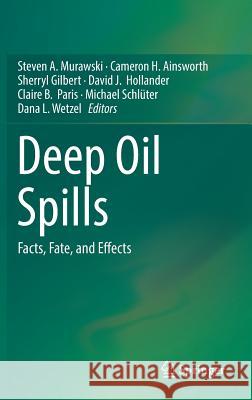Deep Oil Spills: Facts, Fate, and Effects » książka



Deep Oil Spills: Facts, Fate, and Effects
ISBN-13: 9783030116040 / Angielski / Twarda / 2019 / 611 str.
Deep Oil Spills: Facts, Fate, and Effects
ISBN-13: 9783030116040 / Angielski / Twarda / 2019 / 611 str.
(netto: 573,71 VAT: 5%)
Najniższa cena z 30 dni: 578,30
ok. 22 dni roboczych
Dostawa w 2026 r.
Darmowa dostawa!
Section 1 Preface & Introduction
Deep oil, the setting and evolution of exploration and production (emphasis on Gulf of Mexico),
include aspects of the history of deep spills including DWH, IXTOC‐I, Brazil, 2011 (Chevron), and “Deep Spill”, a field‐oriented research project that released oil off Norway.
Section 2 Physics and Chemistry of Deep Oil Blowouts
Impacts of petroleum type (API and GOR), reservoir characteristics (pressures and geometry),
water depth (pressure), water temperature and other factors on multi‐phase flows (oil, gas,
semi‐solids), including hydrate formation. Formation of deep plumes of oil droplets and
impacts of the use of dispersants in the deep sea.
Section 3. Transport and Degradation of oil from Deep Blowouts
Near‐ and Far‐Field transport modeling (e.g., both height above the blowout, and 4‐dimensional
modeling of oil transport at the surface and at depth. These models will incorporate
experimental findings in (2) above and microbial degradation processes.
Section 4. Oil in the Deep Sea
Transport to the bottom, formation of oil/mineral aggregates, oiled marine snow (“dirty
blizzard”), intersection of deep oil plumes with the bathymetry (“dirty bathtub ring”). Biological
exposure impacts on marine benthos.
Section 5. Impacts of Deep Spills on Plankton, Fishes, and Marine Mammals
Impacts on the uptake and depuration of various species monitored over time, community
organization and community dynamics post‐spill (including plankton, benthic fishes, pelagic
fishes, and large vertebrates including sea turtles and marine mammals). Impacts of
confounding factors such as invasive species (lionfish) in the area of the DWH spills.
Section 6. Toxicology of Deep Oil Spills
Results of exposure studies, uptake and depuration kienetics under both chronic and acute
(lethal to sub‐lethal) exposures and mixtures of both. Genotoxic effects in multigenerational
exposure experiments. Relation to field data, toxicokienetics modeling and impacts on
community structure and population dynamics.
The demand for oil and gas has brought exploration and production to unprecedented depths of the world’s oceans. Currently, over 50% of the oil from the Gulf of Mexico now comes from waters in excess of 1,500 meters (one mile) deep, where no oil was produced just 20 years ago. The Deepwater Horizon oil spill blowout did much to change the perception of oil spills as coming just from tanker accidents, train derailments, and pipeline ruptures. In fact, beginning with the Ixtoc 1 spill off Campeche, Mexico in 1979-1980, there have been a series of large spill events originating at the sea bottom and creating a myriad of new environmental and well control challenges. This volume explores the physics, chemistry, sub-surface oil deposition and environmental impacts of deep oil spills. Key lessons learned from the responses to previous deep spills, as well as unresolved scientific questions for additional research are highlighted, all of which are appropriate for governmental regulators, politicians, industry decision-makers, first responders, researchers and students wanting an incisive overview of issues surrounding deep-water oil and gas production.
1997-2025 DolnySlask.com Agencja Internetowa
KrainaKsiazek.PL - Księgarnia Internetowa









